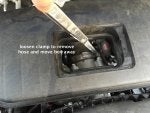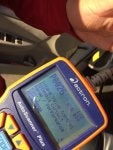From the research I did I found this part to be problematic and often the cause for oil leaks. I was glad to have found that out since after buying my 07 Outback I was very concerned the oil leak I noticed the day after driving home might have been head gaskets. So, as I am implying, I am glad to find it was just a leaky sensor.
This is a quick pictorial of how to replace that pesky sensor.
Difficulty:
Easy
Time:
About 30 min.
Tools Need:
15/16 deep socket or open wrench
19mm open wrench (if using 15/16 open wrench)
8mm (or flat head screwdriver)
Engine De-greaser
Water/Garden Hose
Shop Rag
Safety Glasses
Part(s)
OEM Oil Pressure Sensor
#25240AA060
$16.24
![Image]()
![Image]()
Steps
Once you have located the oil pressure sensor (white plug) and put on your safety glasses, you may begin.
![Image]()
Step 1
Using the 8mm socket or flat head screwdriver, remove the snorkus - plastic tubing between the air intake box and the air filter box.
![Image]()
Step 2
Unplug the sensor(s). If you are using a 5/16 deep sock, you will only need to unplug the oil pressure sensor (white plug). If you don't have one (like me) then you'll use an open wrench - which means you will need to unplug the other sensors (green and blue) so you can move the wrench to loosen and tighten the oil pressure sensor.
Note:
If using 15/16 open wrench, you will need to remove the sensor just beyond the oil pressure sensor (will have to look up or be told what its for) using the 19mm open wrench.
Step 3
Use the 15/16 wrench/socket to remove the leaking oil pressure sensor. Wipe the area with your shop rag. Install the new oil pressure sensor.
![Image]()
![Image]()
![Image]()
Step 4
Reinstall the snorkus.
![Image]()
Step 5
Read the Directions for Use on the can of engine de-greaser that you purchase. With the snorkus install [important] lower the can into the engine bay, near the firewall and spray the cleaner onto the back of the motor where the oil pressure sensor screws into the block. Work your way down to the engine cross member and generously cover the area in front of the drive axle. From underneath, spray all the areas from the oil pan, to the center jack plate, and up to the head and valve cover areas. I imagine you are familiar with this area since you would have been looking here to diagnose the leak to begin with - so you know where the oil residue from the leak has accumulated.
Step 6
As with most engine de-greasers, you will have to wait five minutes (time may vary). Get your garden hose ready and turned on. I used running water and my thumb to better control the water pressure when rinsing the area sprayed - to keep it from splashing back in my face/eyes (which wouldn't be that big of a deal since I am wearing my safety glasses - but I imagine the stuff doesn't taste that good).
Step 7
As with any repaired/replaced you will want to inspect the area once you've started the car back up, driven it around the block, parked, and left to cool off. Check for leaks on the bottom of the sensor, where it meets the block as that would most likely be where any leaks would be at this point.
You'll want to check the car over the next few days to confirm that did indeed resolve that issue and that you tightened the sensor(s) properly.
Hope that helps.
Comments welcome (like what are the other sensors nearby).
This is a quick pictorial of how to replace that pesky sensor.
Difficulty:
Easy
Time:
About 30 min.
Tools Need:
15/16 deep socket or open wrench
19mm open wrench (if using 15/16 open wrench)
8mm (or flat head screwdriver)
Engine De-greaser
Water/Garden Hose
Shop Rag
Safety Glasses
Part(s)
OEM Oil Pressure Sensor
#25240AA060
$16.24
Steps
Once you have located the oil pressure sensor (white plug) and put on your safety glasses, you may begin.
Step 1
Using the 8mm socket or flat head screwdriver, remove the snorkus - plastic tubing between the air intake box and the air filter box.
Step 2
Unplug the sensor(s). If you are using a 5/16 deep sock, you will only need to unplug the oil pressure sensor (white plug). If you don't have one (like me) then you'll use an open wrench - which means you will need to unplug the other sensors (green and blue) so you can move the wrench to loosen and tighten the oil pressure sensor.
Note:
If using 15/16 open wrench, you will need to remove the sensor just beyond the oil pressure sensor (will have to look up or be told what its for) using the 19mm open wrench.
Step 3
Use the 15/16 wrench/socket to remove the leaking oil pressure sensor. Wipe the area with your shop rag. Install the new oil pressure sensor.
Step 4
Reinstall the snorkus.
Step 5
Read the Directions for Use on the can of engine de-greaser that you purchase. With the snorkus install [important] lower the can into the engine bay, near the firewall and spray the cleaner onto the back of the motor where the oil pressure sensor screws into the block. Work your way down to the engine cross member and generously cover the area in front of the drive axle. From underneath, spray all the areas from the oil pan, to the center jack plate, and up to the head and valve cover areas. I imagine you are familiar with this area since you would have been looking here to diagnose the leak to begin with - so you know where the oil residue from the leak has accumulated.
Step 6
As with most engine de-greasers, you will have to wait five minutes (time may vary). Get your garden hose ready and turned on. I used running water and my thumb to better control the water pressure when rinsing the area sprayed - to keep it from splashing back in my face/eyes (which wouldn't be that big of a deal since I am wearing my safety glasses - but I imagine the stuff doesn't taste that good).
Step 7
As with any repaired/replaced you will want to inspect the area once you've started the car back up, driven it around the block, parked, and left to cool off. Check for leaks on the bottom of the sensor, where it meets the block as that would most likely be where any leaks would be at this point.
You'll want to check the car over the next few days to confirm that did indeed resolve that issue and that you tightened the sensor(s) properly.
Hope that helps.
Comments welcome (like what are the other sensors nearby).














